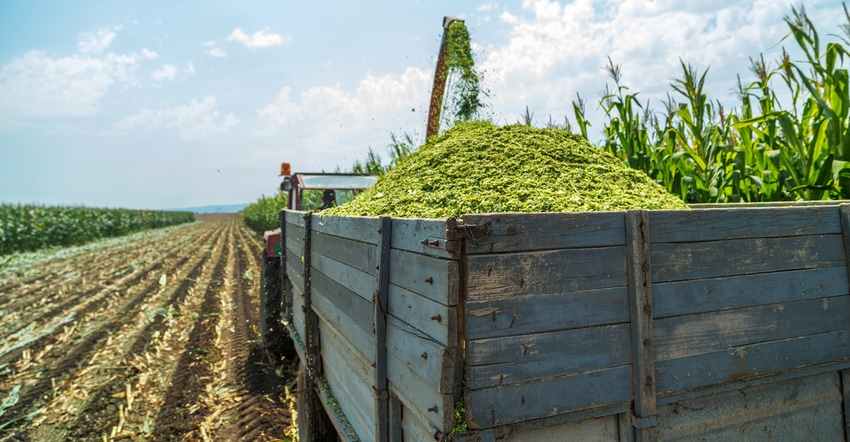
It’s not too late to consider switching up your corn silage hybrids for 2022. If you need help deciding what to plant next year, take a look at the latest university silage trials available online.
New York and Vermont’s trials, led by Cornell’s College of Agriculture and Life Sciences and University of Vermont Cooperative Extension, received 60 entries from 12 seed brands. Early mid-hybrids with relative maturities (RM) of 80-95 days and mid-late hybrids with a RM of 96-110 days were evaluated at four locations in New York and in one location in Vermont.
Penn State’s corn silage trials, which are done in cooperation with the Professional Dairy Managers of Pennsylvania, had 94 entries from 14 seed brands in 2021, way down from previous years, but something that seems to be a common trend with many variety testing programs as of late, says Hanna Wells, a Penn State research technician.
“As with many other things, we believe this is largely due to COVID,” Wells says. “We have not evaluated anything different this year, but have continued working with our new quality tool called the organic matter digestibility index, or OMDI.”
OMDI is a quality index based on digestibility of protein, fat, NDF and starch. It uses wet chemistry to determine NDFD30 and four-hour starch digestibility.
Pennsylvania results
The trials were done on 10 cooperating farms, including the Penn State research farm in Rock Springs. Planting dates ranged from May 3-21, while harvest dates ranged from Aug. 31 to Oct. 1.
The short-season group — RM of 86 to 103 days — showed an average yield of 18.2 tons per acre, ranging from 15.6 to 20 tons per acre. Crude protein averaged 7.4%, while dry matter averaged 43.8%.
The midseason group — RM of 100 to 111 days — showed an average yield of 20 tons per acre, ranging from 18.5 tons to 21.8 tons per acre. Crude protein averaged 6.9%, while dry matter averaged 37.1%.
The medium-late group — RM of 103 to 111 days — showed an average yield of 22.4 tons per acre, ranging from 20.6 tons to 23.9 tons per acre. Crude protein averaged 7.6%, while dry matter averaged 34.9%.
The late group — RM of 107 to 118 days — showed an average yield of 23.1 tons per acre, ranging from 20.3 to 24.7 tons per acre. Crude protein averaged 7.7%, while dry matter averaged 35.2%.
“This year, varieties performed average to above average, especially compared to last year with many drought-stricken sites,” Wells says. “We had timely rainfalls and plenty of growing degree days to provide us with a good crop.”
New York, Vermont results
Depending on the groups and location, planting dates in New York and Vermont varied from as early as May 7 to as late as May 20.
The 80- to 95-day hybrids were planted May 13 in Oakfield, N.Y.; May 7 in Alburgh, Vt.; and May 19 in Willsboro, N.Y. Harvest dates ranged from Sept. 3-10.
The 96- to 110-day hybrids were planted May 12 in Madrid, N.Y.; May 11 in Alburgh, Vt; and May 20 in Aurora, N.Y. Harvest dates ranged from Sept. 14-17.
Yields for the shorter-season group ranged from a 19.9-ton average in Alburgh to 29.1 tons in Oakfield. The late group ranged from 23.9 tons in Alburgh to 32.5 tons in Madrid.
“Total entry numbers were down this year, as I understand they were with other programs, too,” says Joe Lawrence, dairy forage systems specialist for Cornell Pro-Dairy. “I don’t know … any one reason for this, a lot of moving parts, but we hope to see things rebound next year. Overall, the average number of hybrids entered per brand was about the same, just fewer total brands entering.”
While no new analyses were performed in 2021, Lawrence says a big focus of the trials was work on the Cornell Net Carbohydrate and Protein Synthesis model that’s used to evaluate overall forage quality based on how silage is predicted to act within a cow.
“We also continue to focus on tracking the impacts of weather conditions during the growing season on crop performance, specifically fiber digestibility,” he says. “In general, the season started out dry in May and June, and turned wet in July and August, particularly north of … Interstate 90 (the Thruway) in New York.
“With growing degree day accumulation generally above average, this resulted in some very strong crop yields and high starch content, particularly at our New York locations. The Vermont location remained very dry throughout the season. However, fiber digestibility is generally lower … compared to 2020. This will necessitate some changes in feeding programs for farms as they switch to 2021 corn silage.”
About the Author(s)
You May Also Like






